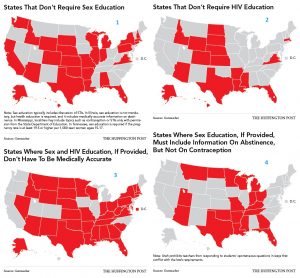The progression of sexual education in America
February 16, 2018

Teenagers are taught that, when it comes to sex, it is in a “say no evil, see no evil, and hear no evil” bias and should not be a topic of concern.
When students think back on sexual education, the infamous “video” about sexual organs in elementary school comes into memory. It was embarrassing, awkward, downright scary, and a laughing matter among children, but when students grow up, would they rather want the opportunity to learn more about their bodily developments, the safeties of sexual intercourse and finding sexuality, or would they rather stay with the current method that is not too far off from the movie Mean Girls sex ed class which consisted of the teacher saying, “Don’t have sex – because you will get pregnant and die.” Today in America, the sexual education teaching program has stuck to traditional methods of abstinence only and although national attention has been drawn to issues of rape, sexual assault, teenage pregnancy, STDs and finding one’s sexuality.
Teaching sexual education starts as early as elementary school for students to learn about preventable diseases, their changing bodies, and the opposite sex. The Institute for Reproductive Health supports sexual education in elementary schools and said, “Starting sex ed in primary school helps avoid unintended pregnancies, maternal deaths, unsafe abortions and STDs.” The importance of teaching sexual education in early years is important because it informs students about the changing anatomy of their own bodies and how it will affect them. Students need to know that what goes on and feelings they may have are normal and should not raise panic among themselves. As a general proposition, many people would agree that there needs to be something taught to children about puberty and/or sexual education. Disagreements arise with what should be taught to students. It is known that the current teaching method in America. When teaching children sexual education, this method comes across as if everyone needs to be sheltered from sex and thoughts of sexuality, as if it was dangerous or deadly. The reality is that kids will find out about it one way or another that sex exists. The topic is prevalent, even in elementary school, but the information kids are getting should not come from their elementary school peers.

This graph shows that southern U.S. states have the highest recorded sexually transmitted diseases than other states.
Unfortunately in certain states, sexual education isn’t required to be taught to students. According to The Guttmacher Institute, “Only 24 states require sexual education, and only 13 of those states require the information being taught to be medically accurate”. The United States education system believes that sexual education is not as vital of a learning point as it really is. According to Newsweek, “This shaming attitude towards sex ed began around the mid-19th century when the department of education was influenced by ministers and priests”. The education system was greatly influenced by the church’s writings of resisting temptation and remaining abstinent. By the turn of the century, a large interest in sexual education grew along with urbanization. However, this original religious influence has continued to impact today’s sexual education.
In 1918, Newsweek.com has recorded that “The American Hygiene Association led the cause of teaching soldiers during World War I about venereal diseases and the consequences of them. Following about a decade later, in 1928, these teachings were later integrated into the public education system, but students were still taught certain topics such as the “dangers” of masturbation in men and how it stunts growth”. While America’s methods of teaching have improved, the traditional ways of teaching do not include other necessary topics should be discussed.

Teenagers who aren’t taught sexual education are left clueless in how to practice safe sex and ultimately, southern states show the highest birth rates as well among other states because of this lack of education.
EFFECTS IN OWATONNA
In Steele County, teen birth rates have been decreasing since 1990, but still in the top ten of the state.The University of Minnesota Prevention Research Center states that, “The overall decline in the adolescent birth rate over the past two decades has been attributed to increased use of the most effective contraceptive methods (IUDs and implants) as well as delayed initiation of sexual activity.” Guttmacher Institute author Dr. Laura Lindberg reported on teenage pregnancy and contraceptive use, and quotes, “Teen sexual activity remains steady, while improved contraceptive use is likely driving declines in teenage pregnancy.” These uses of certain contraceptives have decreased the risk in teenage pregnancies between ages 15-19, and has dropped about 28% over the past 10 years. Once a girl does become pregnant at OHS, they are offered information and assistance by the school nurses. School nurse Amy Jo Havelka, said, “When we hear of a pregnancy, we schedule a meeting with them to give them access to a bunch of resources we have in Owatonna. We just talk through it with them and make sure they’re getting the support they need and try to get them set up with outside help.”
While birth rates are down in Minnesota, STD’s are up. According to the Center for Disease Control and Prevention (CDC), an STD or STI are passed from one person to another through intimate physical contact. STDs are very common. In fact, the CDC estimates 20 million new infections occur every year in the United States. The Guttmacher Institute reports, “States that abide by abstinence-only sexual education have the highest teen pregnancy rates in the country, almost entirely localized around the southern region of the United States.” It is curious as to why this is the case. The University of Minnesota conducted a study and said, “Adolescents and young adults experience a high incidence of STIs compared to other age groups. This disparity is likely related to a lack of access to STI prevention services, socioeconomic status, discomfort with facilities designed for adults and concerns about confidentiality.” With a 15% increase in chlamydia and a 40% increase in gonorrhea from 2015-2016, the cause is from adolescents lacking a more effective sexual education and the stigma around sex that has been caused by the current methods of sexual education found in elementary schools and high schools.
GLOBAL IDEAS

Statistics showing that states who don’t require sexual education to be taught in their schools tend to show higher birth rates and STD infections among the population.
The most effective sexual education courses and least amount of teen pregnancies and STIs can be found in European countries. The question to address is – what are European students learning that American students are not? Attn.com reports on the issue, stating that “The Netherlands educates children as young as four about sex. This doesn’t mean children have explicit conversations about the ‘birds and the bees’.” Rather, children learn how to form relationships and to discuss sexuality. According to pbs.org, the Dutch philosophy is to encourage respect for all sexual preferences and to help students develop skills to protect against sexual coercion, intimidation and abuse. All elementary students in Dutch elementary schools are required to receive some type of sexual education. The curriculum for these countries is centered around informing students that sex is a positive and normal activity, rather than emphasizing the dangers of sex. To put it simply, Europeans are accepting that people – including teens – have sex. Heather D. Boonstra, the public policy director of the Guttmacher Institute, said, “Sex among adolescents [in Western Europe] is generally accepted, with little to no societal pressure to remain abstinent. But with that acceptance comes strong cultural norms that emphasize that young people who are having sex should take actions to protect themselves and their partners from pregnancy and STIs.”
Europe is not the only place to find progressive sexual education. The Guardian studied multiple countries with limited sexual education and the programs looking to make a change. The Guardian said, “The YP foundation set up a progressive curriculum to teach young people about gender equality, sexual diversity and consent. In Nicaragua, “Macho, sexist and traditional attitudes can disempower women. To tackle them, Plan International is educating young men.” Whereas in Romania, the Keep Me Safe program offers consent classes for people with learning difficulties. By following in these countries footsteps, there could be improvements in America’s social gaps, gender equality and improved cultural norms.
NOW WHAT?
While America’s current situation is less than ideal, it is not too late to turn things around. OHS’s women health issues course is progressive, given that most sex ed courses aren’t particularly woman or LGBTQ friendly. Sexual safety tends to be geared towards teaching girls to say no, rather than boys accepting rejection. As for LGBTQ students, MNWomen states, “Minnesota teachings tend to be incredibly heteronormative. LGBTQ kids feel like they’ve been left entirely out of the conversation.” Seniors believe that, in regards to sex ed teaching at OHS, there is still very much to improve in that topic. OHS’s course is highly beneficial to these marginalized groups and effectively delivers the information they need. Being that Owatonna leans towards a more conservative point of view, the nurses at OHS are not allowed to hand out contraceptives. Providing birth control to students who do not have access to it otherwise may be the next step to progressing student’s sexual health at OHS.
Although sexual education in America still stands true with traditional methods of teaching of abstinence, improvement is gradually being made, and young people are being commended for learning how to make wise choices about their sexual health. However, further improvement and openness about sexual education will help them make more wise and healthy choices. Restricting student from accessing information on sexual safety could be argued to be against human rights as sexually reproductive beings, and the world will continue to open its eyes to that truth. As America continues to move in the direction towards informative programs, increased positive attitudes towards sex and taking responsibility for educating the next generation, the future of sexual health in America will get brighter day by day.
